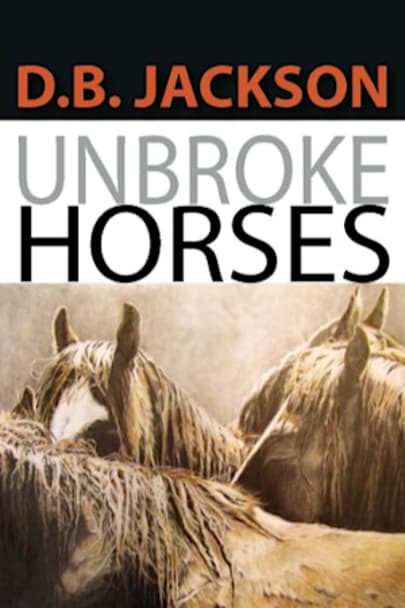UNBROKE HORSES winner of the Triple Crown of Western literature awards: Western Heritage Wrangler Award, Will Rogers Medallion Award, and the Western Fictioneers Peacemaker Award. It also won the Laramie Award, and the Eric Hoffer Award for literature, and was a finalist for the daVinci Eye Award for cover design.An innocent 14-year old preacher’s son is kidnapped by three vile Civil War … preacher’s son is kidnapped by three vile Civil War deserters. When turning-the-other-cheek fails to deter their cruelty, the boy resorts to his own violent behavior for survival, and the retribution he exacts from them casts him in a new struggle, this time for his soul. His redemption comes down to the wisdom of an old man and a small band of unbroke horses.
more



D.B. Jackson’s second novel, Unbroke Horses, is a dark, compelling tour de force. It is also, incidentally, a Western. The first half of the novel follows the brutal exploits of General Ike Smith and his unsavory Confederate cohorts towards the end of the Civil War as they pillage the countryside. It is unrelenting in its brutality. After killing his parents and most of his neighbors, they kidnap the fourteen year old protagonist and keep him tethered by a rawhide thong as they continue on their spree of robbery, mayhem and murder.
They kill most of the posse that is finally formed to track them down, with the exception of one farmer whose wife had been murdered by the gang. J.T. Elder, a relentless pursuer finally joins up with the young Matthew Stanford who manages to escape his captors. Together they exact a bloody justice including a cruel revenge on the part of Matthew who shoots off the limbs of one of the miscreants with a shotgun before finally dispatching him. This horrendous act scars his soul.
The second half of the novel is how J.T. Elder secures him a job at a ranch in Montana where the boy learns how to break horses with an old Indian. As in Horse Whisperer by Nicolas Evans to which this novel has been favorably compared, the boy’s redemption is at stake in this effort which is far from certain of success. Before the boy could even settle in at the bunkhouse and learn the skill of branding cattle, he had already threatened a seasoned cowhand with a pistol. He probably would have murdered him if his gun arm was not pushed away by a bunkmate in time. The job with the Indian in the horse corral is his last chance, but his disrespect for the Indian and his hatred for one untamed horse which attacked him, does not bode well for his rehabilitation.
In the editorial review above the reader is told that the unmitigated violence in this novel is akin to that of Cormac McCarthy in Blood Meridian. However, I would suggest that the better comparison with McCarthy is not so much the blood and gore but rather the lyrical prose which transcends the violence and forms within the book a larger, more complex canvas in which universal themes play out. After a wild shootout in a barroom in which Ike Smith is killed, the author writes:
“The gunsmoke that filled the room coiled upward and hovered about in the stale air, and rose to the cracked and yellowed ceiling. Shafts of brilliant sunlight split the smoke and cut across the room at an oblique angle and, for the moment, the silence that ensured was that of a mute kaleidoscopic dream in which no one spoke and no one moved, and when something did move it made no sound. And the red of the dreamscape that was blood was only a color widely splashed about and had no significance. And there was no significance to the blank stare of Ike Smith whose eyes were the eyes of a corpse, no more and no less dead than those he himself dispatched without regard.”
Even when claiming that there is no meaning in the mindless violence, the author suggests in the very lushness and beauty of his language that there is significance in the world itself. In the midst of this repulsive horror, there are pattern of symmetry and brilliance which rise above the ugliness, just as the smoke rises through the stale air in a shaft of sunlight.
Here we have a cowboy tale in the best tradition of Zane Gray, Louis L’Amour, A.B. Guthrie and James D. Best. There is also the coming of age story of a boy forced before his time to become a man, and the attempt to undo some of the psychic horror that may turn him into a cold and sadistic adult and a danger to those around him. But running through all that is the poetic voice of the narrator who not only senses but actual attributes a spiritual foundation to this world so scorned and trespassed by evil men. He writes:
“They rode down a gradual slope of sweet spring grass scattered about with small white flowers that grew like the hand that put them there did so purely for the beauty of it. They maneuvered the horses between dense stands of buckbrush and the magenta-colored western redbud trees that populated the areas and make the going hard.”
This is a book that will certainly be optioned for a movie and I have no doubt that it will make a great film. But when makes it a classic novel is neither the compelling plot, nor the universal theme. It is instead the painterly prose of D. B Jackson who tells us a rip-roaring story but at the same time scatters a few white flowers with a sleight of hand that is magical.